Key takeaways:
- Documentary editing blends narrative crafting with technical skills; emotional resonance requires understanding timing and rhythm.
- Film industry training is vital for building skills, fostering connections, and developing resilience through constructive feedback.
- Essential editing skills include storytelling, technical proficiency, and a keen eye for detail, which can significantly impact a project’s quality.
- Collaboration and trusting one’s instincts are crucial; embracing discomfort can lead to authentic storytelling that resonates with audiences.
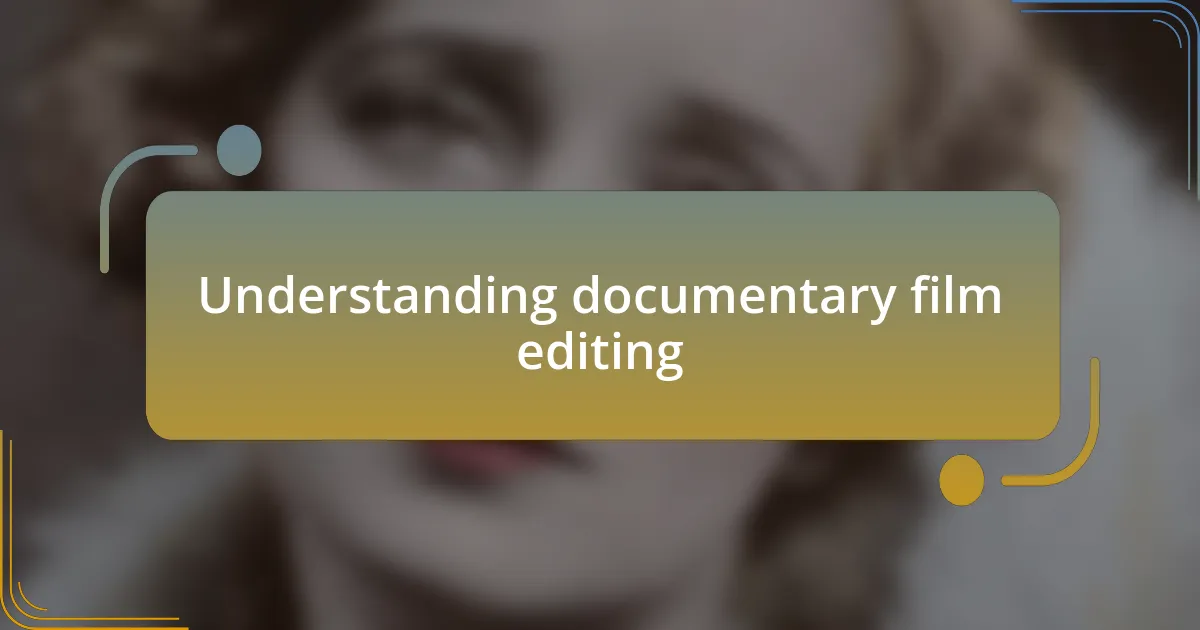
Understanding documentary film editing
Documentary film editing is more than just cutting footage; it’s about weaving a narrative that resonates with the audience. I remember my first experience with editing a documentary—sifting through hours of raw interviews and b-roll. It was overwhelming, but I quickly learned that the real magic happens when you find the emotional core of the story.
Why does a certain cut hit harder than others? This often comes down to timing and rhythm. I’ve had moments where I felt the pulse of a documentary shift dramatically just by tightening a sequence, making it more impactful. Each choice I made in those edits felt like a heartbeat, driving the story forward and pulling viewers deeper into the experience.
As I navigated through different editing styles, I discovered that every documentary has its unique voice, created by how we choose to piece together the narrative. I often ask myself what the visuals are truly communicating. It’s like piecing together a puzzle—each clip adds depth, and sometimes, less is more. Those quiet moments can speak volumes, allowing the audience to connect with the story on a profound level.

Importance of film industry training
Understanding the importance of film industry training is crucial for anyone aspiring to excel in this field. I remember attending a workshop where industry veterans shared their experiences. Hearing their stories about the challenges they faced underscored how essential training is—it not only builds technical skills but also fosters connections that can last throughout one’s career.
Training in the film industry provides a solid foundation in both theory and practice. Without it, I believe emerging filmmakers risk stumbling through their journeys. I once worked with someone who, despite being incredibly creative, lacked formal training. They struggled to translate their ideas to the screen, highlighting how training can bridge the gap between creativity and execution.
Moreover, investing time in training cultivates resilience and adaptability. During my early editing days, I learned to embrace constructive criticism. That process was not easy, but it was invaluable. Would I have developed such a thick skin without that initial training? I doubt it. Each piece of feedback shaped my approach, allowing me to grow and flourish in my craft.
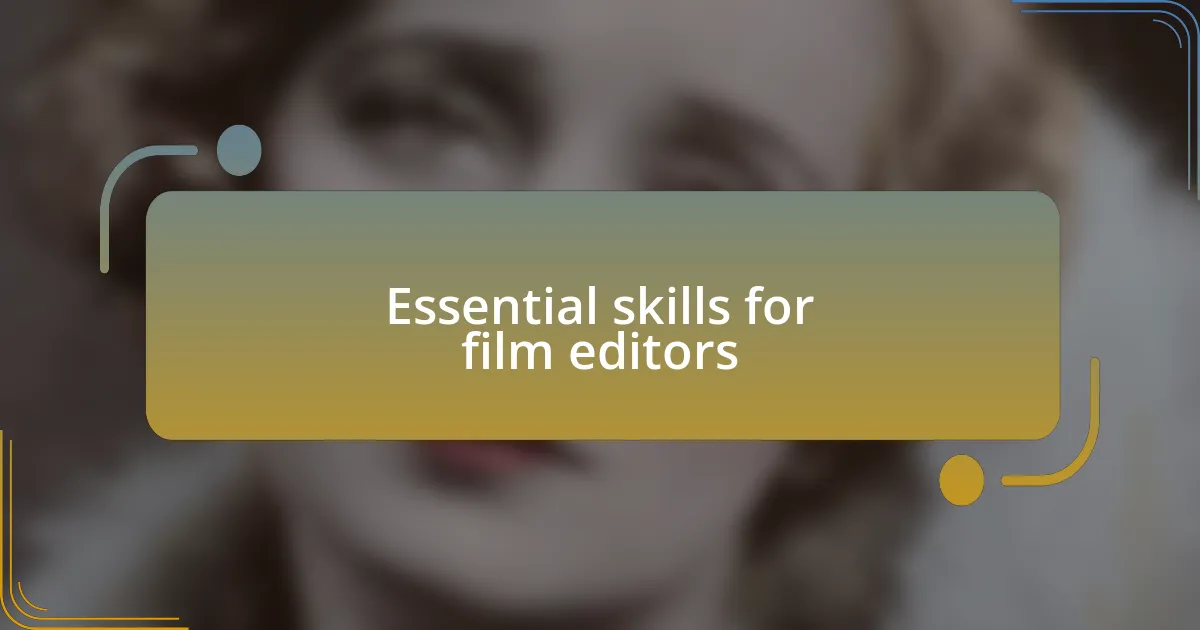
Essential skills for film editors
Understanding the essential skills for film editors is truly a journey in itself. First and foremost, a strong sense of storytelling is vital. I vividly recall editing a documentary where the narrative arc felt disjointed. It wasn’t until I honed my ability to identify the emotional threads of the story that everything clicked into place. Why is this skill so crucial? Because it allows editors to weave together disparate pieces into a cohesive, impactful narrative.
Technical proficiency is another cornerstone of effective film editing. I remember feeling overwhelmed by software interfaces when I first started. However, dedicating time to learn the ins and outs of editing tools not only boosted my confidence but also my efficiency. Have you ever found yourself in a tight editing deadline, struggling with software hiccups? I have, and mastering these technical skills made all the difference, transforming pressure into creativity.
Lastly, developing a keen eye for detail can set a film editor apart. During one project, a seemingly insignificant cut slipped past my notice, affecting the pacing of an entire scene. That experience taught me the importance of meticulous review. Are you someone who can spot inconsistencies or oddities in a sequence? Cultivating that skill is essential; it can be the fine line between a good film and a great one.

Developing a personal editing style
Finding your personal editing style is akin to discovering your voice as a storyteller. I can still remember the moment where I decided to step away from conventional cutting techniques and embrace a more fluid approach while editing a documentary about artists. This shift allowed me to focus on the emotional flow rather than strictly adhering to a formula. Have you ever felt stifled by rules? Breaking free of those limits can often lead to more genuine artistic choices.
Experimentation is an essential part of developing your unique style. I underwent a phase where I tried integrating unconventional transitions and pacing in my edits. Some projects were met with criticism, but those moments were crucial for refining my aesthetic. Did you ever experiment with a bold choice that, in hindsight, shaped your work? Embracing risk can pave the way for innovative storytelling that resonates with audiences on a deeper level.
Ultimately, your editing style evolves as you gain more experience. Reflecting on my earlier work, I realize that each project contributed to a growing sense of self within my edits. The pieces I felt most passionate about all shared a common thread—an authentic connection to the subject matter. How do your projects reflect your personal style? Recognizing those patterns can empower you to hone your craft and align your editing with your true artistic vision.
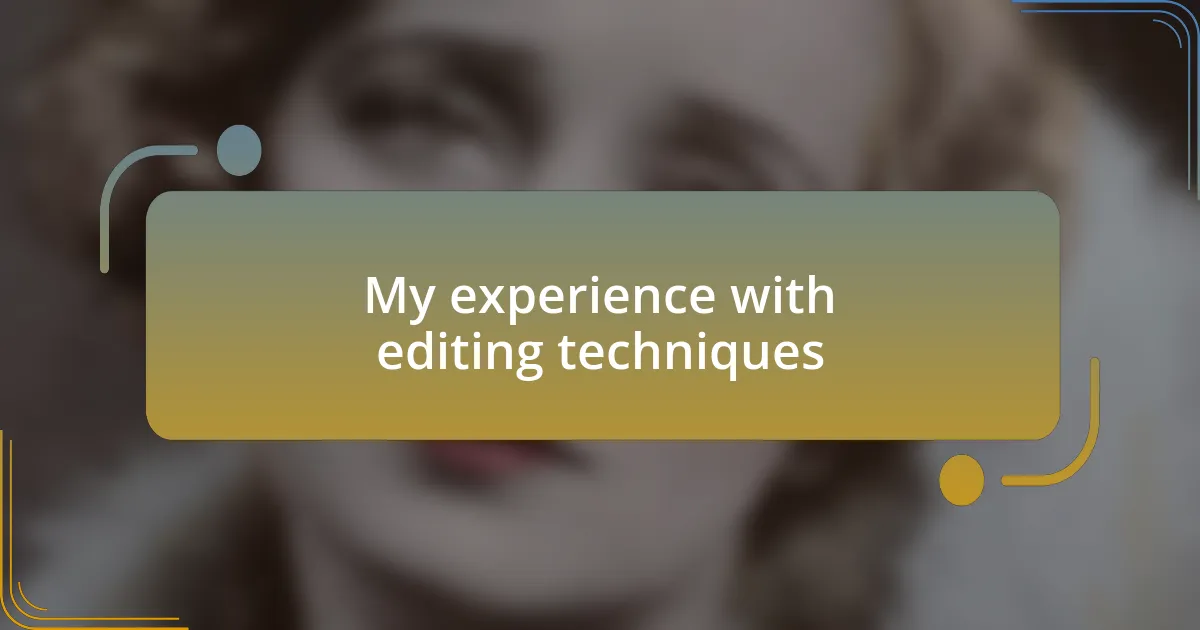
My experience with editing techniques
When I first delved into various editing techniques, I found myself fascinated by the power of pacing. I recall working on a documentary that revolved around a local musician. By carefully manipulating the rhythm of the cuts, I was able to convey not just the story but the heartbeat of the music itself. Have you ever noticed how a well-timed edit can elevate a piece from ordinary to extraordinary?
Overlaying visual and audio elements has also become a staple in my toolkit. During my editing of a documentary featuring environmental activists, I experimented with layering sound bites over relevant visuals, creating an immersive experience. This technique allowed me to intertwine their messages with striking imagery. It made me wonder: how can audio enhance the emotional weight of visual storytelling for you?
Additionally, I’ve learned the value of color grading and its impact on mood. For instance, in a project about urban life, I chose a cooler color palette to emphasize the stark realities faced by residents. The response from viewers was overwhelmingly positive, and it got me thinking—how much can color influence the perception of a story? Crafting these choices has not only shaped my work but also deepened my appreciation for the artistry of editing.
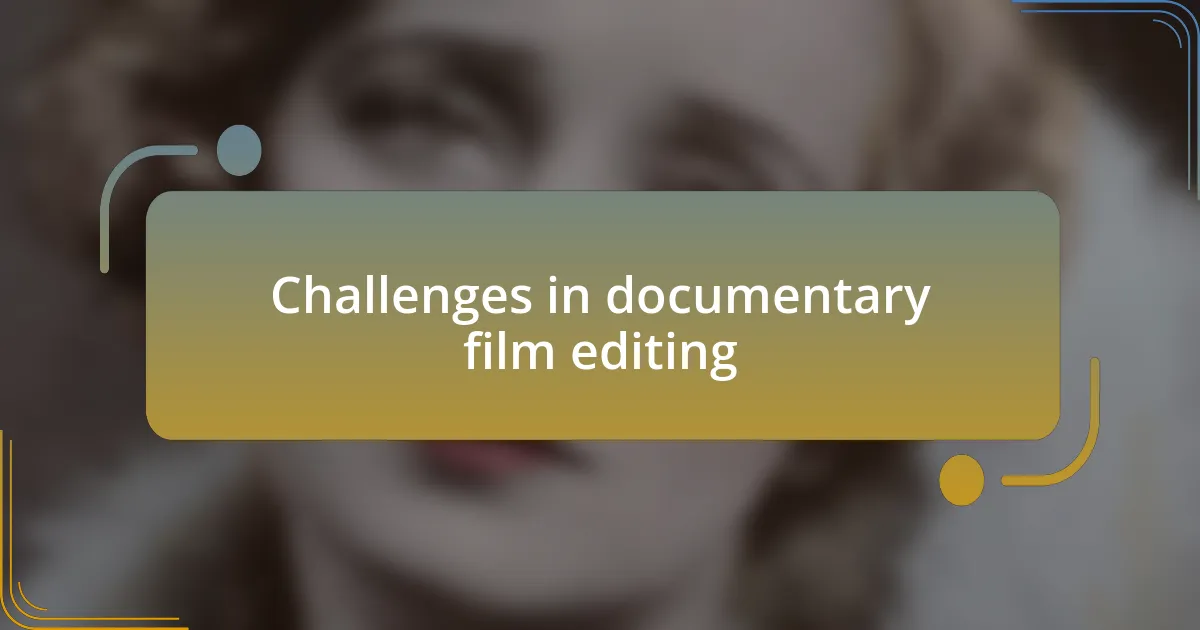
Challenges in documentary film editing
Editing a documentary often brings unexpected challenges that test both technical skills and creative intuition. One hurdle I faced was the delicate balance between narrative flow and factual representation. I remember working on a project about a marginalized community, and while my aim was to tell their story authentically, I struggled with how to weave their harsh realities into a cohesive narrative that also remained respectful. Isn’t it tough to find that sweet spot between storytelling and integrity?
Another significant challenge is managing the vast amount of footage. While sifting through hours of interviews and B-roll, I found myself overwhelmed, unsure of how to encapsulate the essence of each moment. In one particular film about cultural traditions, I had to decide which poignant stories to highlight. Each clip held meaning, yet I learned that sometimes, less truly is more. How do you prioritize memorable moments without diluting the narrative?
Moreover, working with emotionally charged subject matter can be heavy. I vividly recall editing a piece focused on a social justice movement, where the struggle and resilience of the individuals almost affected my own emotional state. It made me question: how does one maintain objectivity while charged with the emotional weight of their stories? This internal tug-of-war often leads to a richness in the final edit but requires a careful touch to honor the subjects’ voices.
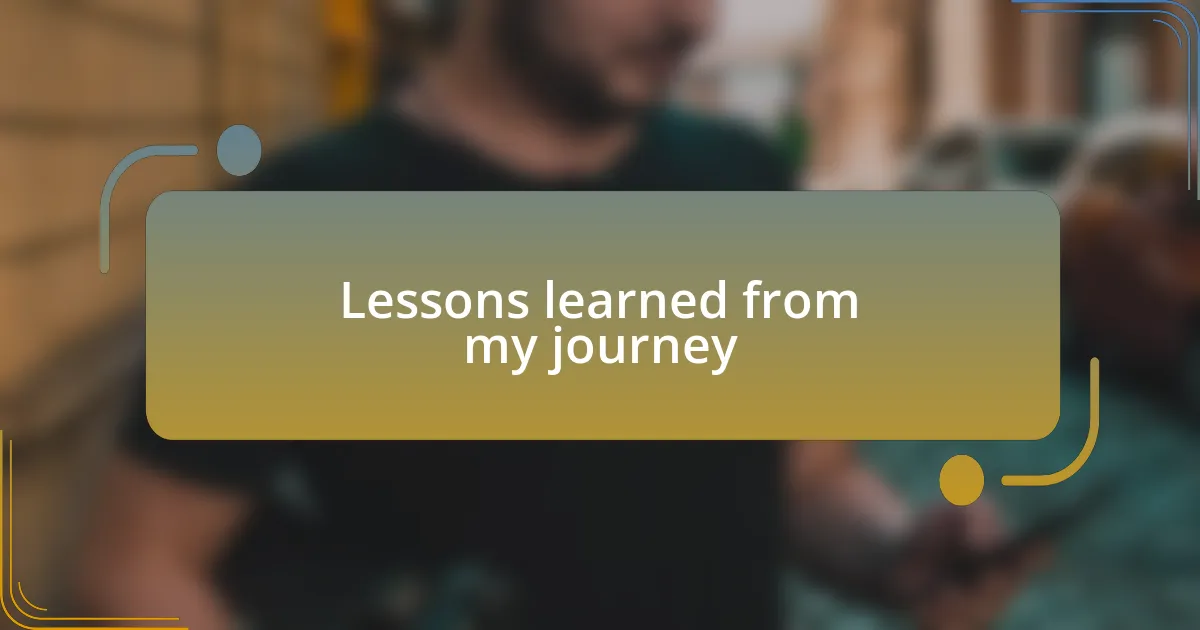
Lessons learned from my journey
Throughout my journey in documentary film editing, I’ve discovered that collaboration is crucial. One poignant experience I had was during the editing of a film about environmental activists. As I worked alongside the director, we often found ourselves in heated discussions about which narratives deserved more airtime. Through these exchanges, I learned the value of diverse perspectives; sometimes, stepping back and allowing others to weigh in can enhance the film in ways you hadn’t considered. Have you ever noticed how collaboration can spark unforeseen creativity?
Another lesson I encountered was the importance of trusting my instincts. While editing a documentary on mental health, I initially hesitated to include some raw, vulnerable moments from the interviews. I worried about how they would be perceived. Eventually, I listened to my gut and included those intimate segments, which ultimately resonated with viewers more than I could have anticipated. This experience reinforced a powerful insight: authenticity often lies in our willingness to embrace discomfort. Have you ever felt torn between what feels right and what you think others might expect?
Finally, I learned that pacing is everything. In one particular project about the refugee experience, I was amazed to see how the rhythm of the edit could transform the emotional impact of the story. By strategically placing moments of quiet reflection between intense sequences, I found that I could allow viewers to absorb the weight of what they were witnessing. It made me realize how crucial it is to guide the audience’s emotional journey. Have you reflected on how pacing shapes the narrative flow in your projects?